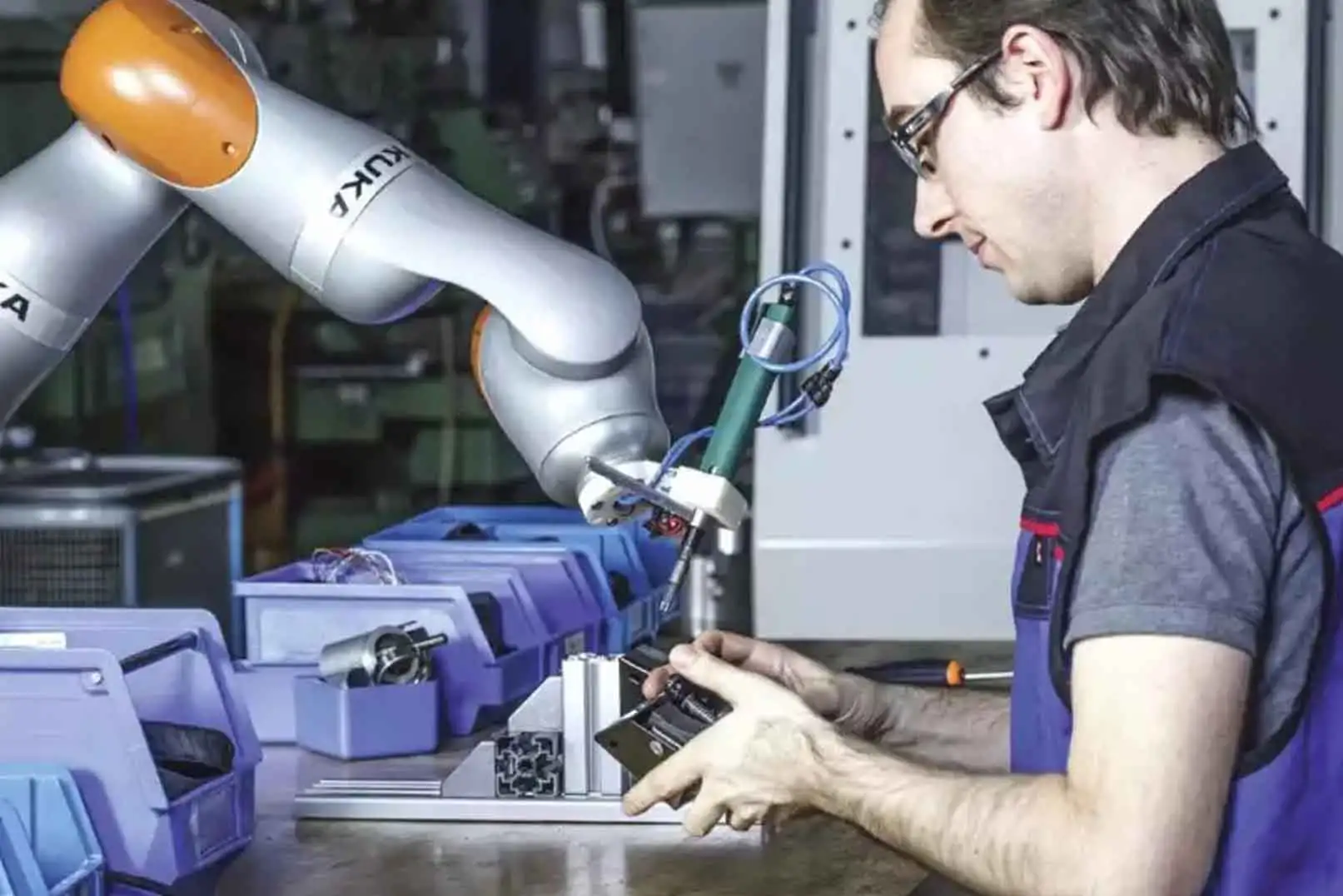- advantages of cobot
- Advantages of Cobots
- cobot for manufacturing industry
- cobot manufacturers in india
- cobots
- cobots in manufacturing
- Disadvantages of Cobots
- Future of Cobots
- Future of Cobots in the Manufacturing Sector
- Future of Manufacturing
- perks of cobots in manufacturing sector
- Software Development Solutions
- types of robot in manufacturing industry
- what cobot is offering
- why choose cobot for manufacturing industry
Cobot is a new and advanced automation technology that enables manufacturers of all sizes and types to automate the entire or a small portion of their manufacturing processes. Recently, collaborative robots or cobots have seriously penetrated the manufacturing industry despite different industry challenges caused by workforces and supply issues. Nowadays, business enterprises invest heavily in cobots due to their ease of use, cost-efficiency, and collaborative convenience.
Cobots collaborate with humans to accelerate productivity by offering upskilling opportunities for workforces and reducing the need for unskilled labor. That is why small and medium-sized enterprises (SMEs) see cobots as a popular option to retain flexibility and manageable costs with automation.
Robot Types in the Manufacturing Sector
As its name suggests, a cobot is a collaborative robot that collaborates with humans to enhance their abilities more safely. Cobots are different from traditional industrial robots in terms of flexibility, versatility, ease of setup, and cost. Various types of industrial robots restructure the manufacturing process.
Collaborative Robots
Collaborative robots work alongside people in factories and carry out tasks associated with direct human supervision. They have unique safety features, and they work closely with humans. A mechanical arm is an example of a collaborative robot.
Autonomous Mobile Robots (ARMs)
Factory robots or ARMs can work independently without any human interaction. They use artificial intelligence (AI) to avoid production barriers and workers’ movement. Generally, they help manufacturing units move heavy items from one location to another.
Industrial Robot Arms
Robot arms are like flexible automation tools engineered to execute different tasks on an assembly line. They are widely used in large manufacturing units to move heavy items and hold up products for inspection.
Robotic Blacksmithing
Robotic blacksmithing is a new concept in automation where manufacturing units use robotic arms, sensors, and special tools. This can be a suitable replacement for production with traditional machining. Interestingly, robotic blacksmithing is more sustainable and resource-efficient.
Robots with Machine Vision
Machine vision technology enables robots to perform routine inspections and control quality in the manufacturing process. This technology allows robots to automate quality control tasks. AI gives quality control robots the power to inspect and detect issues involved in more complex tasks.
Also Read: Transform the Manufacturing Industry with Digital Engineering
Advantages and Disadvantages of Cobots
Nowadays, cobots come with advanced safety features so that workers can work effectively with workers. Cobots take over repetitive tasks and enable humans to focus on more complex tasks that demand problem-solving and troubleshooting. If you are a manufacturer planning to implement industrial robots into your manufacturing units, you should know more about the advantages and disadvantages of factory automation and robotics.
Advantages of Cobots
- Increased efficiency of production lines
- Improved quality with a high level of accuracy
- Improved health and safety
- Increased profitability and saving on time and resources
- 24/7 working hours at 100% efficiency
- Happy clients with automated production
- Reduced waste at the manufacturing unit
Hire Now: What is AI as a Service
Disadvantages of Cobots
1. Higher Costs
Industrial robots can be costly to implement, but they can deliver exceptional ROI. It is essential for you to consider initial costs with expected ROI thoroughly before investment.
2. Training and Expertise
Implementing industrial robots needs a high capital cost and a workforce with the proper skill set. It is easy to get a support package from automation companies. But you also need to train engineers so that they can program the robots.
3. Restrictions
Remember that industrial robots also have some limitations regarding their performance tasks. It will be good if you can communicate with automation companies before implementing industrial robots in manufacturing units.
Read More: All About Performance Testing to Performance Engineering
The Future of Cobots in the Manufacturing Sector
According to recent reports from ABI Research, a NY-based data research company, the cobot market was valued at $600 million in 2021. The same demand is expected to reach $8 billion in 2030, at a CAGR of 32.5%. It means the market is ready for substantial growth within the next ten years.
Industry 4.0 relies on automation and smart manufacturing empowered by data-driven technologies like AI, cognitive computing, IoT, cyber-physical systems, wearables, and cloud computing. Industry 4.0 focuses on improving process efficiencies. On the other hand, industry 5.0 involves human value in process optimization. That is why cobots seem to be the next big wave of the industrial revolution.
Cobots can democratize robotic capabilities as individual tool that generates value and applies creative skills. Manufacturers can use cobots as a plug-and-play solution in different industrial and manufacturing operations.
When we talk about what is next for cobots, we can expect the intelligent use of cobots along with an upskilled workforce. The ongoing industrial transformation journey and the advent of cobots seem to ensure a vast increase in overall output and efficiency and output. Cobots collaborate with humans in a safe environment. So, they are likely to
- Drive high-quality products to the market
- Increase intelligent decision-making
- Facilitate mass personalization and customization
- Optimize manufacturing costs
- Create new job opportunities and roles
- Boost efforts to make the most of collaborative robots
Combining human skills (human creativity) with the speed of robots (robotic precision) can help manufacturers reduce human interaction in accelerating production cycles. The constant evolution of automation and factory robots indicates the future and growing influence of cobots in manufacturing capabilities.
In the past two decades, the price of robots has fallen by half. That is why overall production costs will fall automatically. This trend is not likely to slow down, making automation and robotics more accessible to manufacturers.
Factory robots and automation is a unique combination in the manufacturing sector that allows humans to operate machinery with reduced engineering time and risk. Now, the assembly, installation, and maintenance of factory robots have become cheaper and faster than before. Thanks to advancements in software and computing power for increased capabilities and agile production in real-time.
Read More: How ServiceNow is Helpful in Manufacturing Sector
The Value Offered by Cobots
Cobots offer manufacturers the most value in conditions where humans and robots work together. Human-robot collaborations enable humans to guide the robots and monitor the manufacturing process. Cobots are a big fit for smart manufacturing, where the quality-of-service requirement is the prime characteristic. Cobots work in a safe zone inside a manufacturing facility. The safety zone largely depends on
- the proximity of obstacles
- the proximity of humans in the same facility
- the pace of movement of the cobot
Effective and reliable communication is also desired to control the system and make timely decisions. When it comes to the cobot in more safety-critical environments, there is a need for fast decision-making capabilities, low latency, a high amount of signaling, and high bandwidth via efficient computing.
There is a discussion on the ability of robots to mimic human decisions and movements. But, AI algorithms have emerged as superior solutions to human discoveries. It would be interesting to see how a collaboration between cobots and humans can make work more efficient.
Also Read: Smart Manufacturing with App Modernization
Conclusion
Emerging technologies have propelled manufacturers to build use cases so that they can make way for effective and flawless robot-human collaboration. The critical applications of cobots in manufacturing include picking, packing, palletizing, welding, assembly, material handling, quality, and inspection. This way, both cobots, and humans can do wonders.
Binmile process automation experts can help manufacturers develop cobot management software and mobile application or custom software solution to address the manufacturing sector’s challenges.
Frequently Asked Questions
Cobots, short for collaborative robots, are robotic systems designed to work alongside human operators in manufacturing environments. Unlike traditional industrial robots, cobots are specifically engineered to interact safely and effectively with human workers.
Several cobot manufacturers operate in India, including:
- Universal Robots: A leading global provider of collaborative robotic arms with a presence in India through authorized distributors
- Techman Robot: Known for its collaborative robot arms featuring advanced vision capabilities and user-friendly programming
- Yaskawa India: Offers a range of collaborative and industrial robotic solutions for diverse manufacturing applications
- AUBO Robotics: Provides collaborative robot solutions suitable for small and medium-sized enterprises (SMEs) in India
- KUKA Robotics India: Offers collaborative and industrial robot solutions for automotive, electronics, and other sectors









